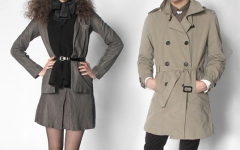Eco-Fashion + Clothing
If you want to look chic while doing your part to save the planet, now you can
Whether a necessity in league with food and shelter, or a luxury to reflect our character and poise, clothing and fashion have a substantial impact in every stage of production and consumption. Our choice of clothing style may ostensibly mirror our mood, preference and geographical climate, but what it's made of and how it's made discreetly reverberates who we are and what we believe in. We become models of our choices, conscious or not.
If you want to look chic while doing your part to save the earth, there are more eco-friendly choices than ever before. The spheres of ecology and economy are intersecting in a new sector of the garment industry: Eco-Fashion. As the spectrum of supply meets the growing crest of demand, some of the fashion-forward eco-designs are about as granola as a pair of Louboutin stilettos. Eco-savvy consumers are now privy to a selection of styles like never before.
Eco-fashion has come a long way, baby. Just a few years ago, when I was filming the pilot of my first TV show, I scoured and scrounged to find just eight wardrobe changes of sophisticated threads. While I knew the camera couldn't read the interior labels for fiber content, I could. Today, there are far more designers and brands proffering eco-collections than could possibly be covered herein. And, it's not just back-to-the-land burlap styles, or even just workout wears. Sure, it's nice to bum around in drawstring pants and a hoodie at home, but what about to an imprtant interview, your cousin's wedding or a night on the town?
The new generation of eco-friendly fibers and fabrics meets almost no limitation. Innovations in technology for natural and recycled fibers translate to organic and eco-friendly fabrics that perform as fabulously as conventional counterparts without the ecological impact.
Eco-fashion is no longer a compromise. In fact, some of the newer fibers and blends are an enhancement of the norm. Designers who are forging sustainable styles are creating and blending an exceptional array of luxurious fibers that leave nothing to be desired except where to buy them.
Natural fibers such as organic cotton, bamboo, soy bean fiber, hemp, seacell and sasawashi; eco-friendly hybrid fibers such as tencel and modal; repurposed vintage fabrics such as cashmere, leather, silk and wool; and recycled fibers made from soda pop bottles, mill end surplus fabrics, cotton, wool and leather.
I must admit, while I do everything within my reach to be sustainable, I do love stuff. Maybe it's because I'm a product of a society where part of the program is to find pleasure in material stuff. I am over the moon to be able to access sustainable stuff because I feel like I can do my part and fit in the world. I have a handbag that is made out of chocolate wrappers. It's a prized possession because it infuses a number of things that are dear to my heart: chocolate, function and form, and finding purpose. In this case, repurposing something destined for the landfill into something far superior than it ever dreamed of being together with utilizing old-school folding and weaving techniques and employing communities in need. It's gorgeous, like Bottega Veneta bag, but made from garbage, and a magnet for compliments from strangers of all walks of life that comment on its savvy shape and craftsmanship without any idea of what it's made out of.
The true cost of fashion is not necessarily printed on the hang-tag of garments and accessories. The cost paid by the planet and the people involved in production rarely make the glossy magazines. While it's possible to scoop up a head-to-toe outfit for less than the cost of dinner at many retail chains, the price tag of most garments invisibly reflects an unaccountable system that feeds an insatiable frenzy of fashion with an impact far beyond a credit card bill.
Fashion is ephemeral, but its environmental impact is not. Cotton laden with pesticides and dyes laden with heavy metals, the extraction of oil to produce synthetics, chemicals used to scour, bleach and finish fabrics, and manufacturing practices that violate human rights all take an irreversible toll on the ecosystem and on humans.
While buying sustainable clothing made from eco-friendly fabrics, colored with low-impact dyes, with fair trade labor is a major piece of conscious consumerism, buying smart and better is part of the fabric of true eco-fashion. Those skinny jeans that were shunned in favor of boot cuts and bell-bottoms just a few years ago are back in fashion. And, by the time you read this, simply reverse the statement, because the inverse will be true soon enough. Buy smart - classic pieces that won't go out of style. Buy better - less stuff of better quality that will last longer. Buy eco - next time you need a new piece of clothing, stop, drop and roll; scout for an eco-version that will make you feel good long after the transaction high.









